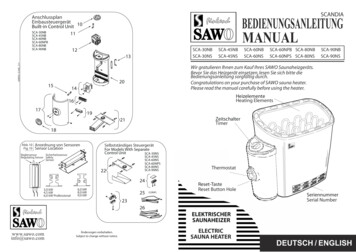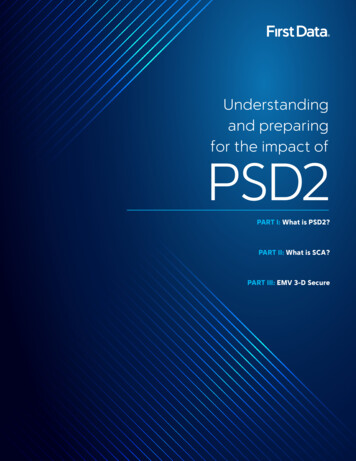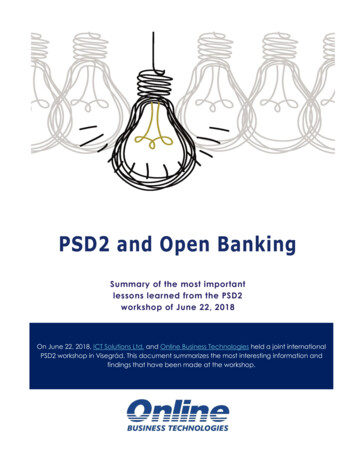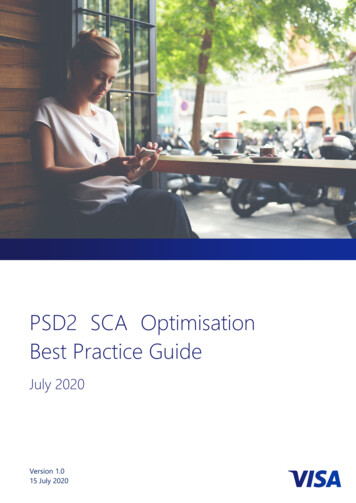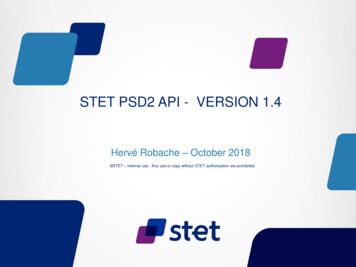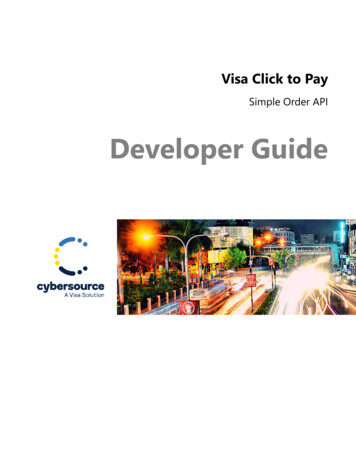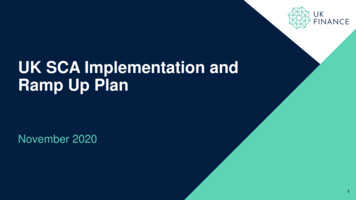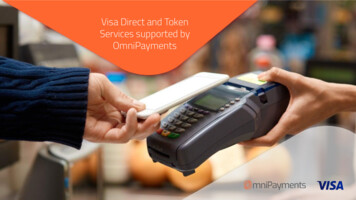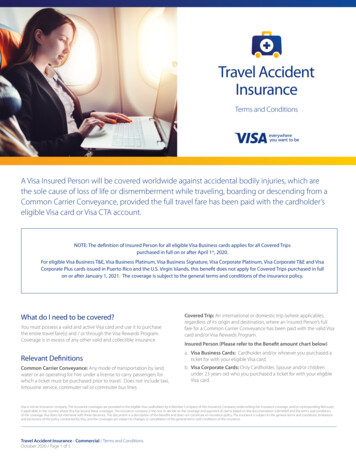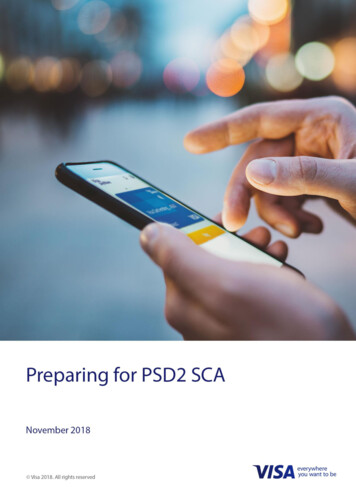
Transcription
1Preparing for PSD2 SCA
Important Information 2018 Visa. All Rights Reserved.The trademarks, logos, trade names and service marks, whether registered or unregistered(collectively the “Trademarks”) are Trademarks owned by Visa. All other trademarks notattributed to Visa are the property of their respective owners.Disclaimer: Case studies, comparisons, statistics, research and recommendations areprovided “AS IS” and intended for informational purposes only and should not be relied uponfor operational, marketing, legal, technical, tax, financial or other advice. As a new regulatoryframework in an evolving ecosystem, the requirements for SCA still need to be refined forsome use cases. This paper represents Visa’s evolving thinking, but it should not be taken asa definitive position or considered as legal advice. Payment Service Providers are encouragedto seek the advice of a competent professional where such advice is required.Note: This document is not part of the Visa Rules. In the event of any conflict between anycontent in this document, any document referenced herein, any exhibit to this document, orany communications concerning this document, and any content in the Visa Rules, the VisaRules shall govern and control.Note on references to 3-D Secure 2.0 (3DS 2.0): When in this document we refer to 3-DSecure 2.0 or 3DS 2.0 this is a generic reference to the second generation of 3-D Secure anddoes reference a specific version of the EMVCo specification. Some 3-D Secure features areonly available under versions 2.1, 2.2 or later of the EMVCo specification. Readers will needto refer to the EMVCo specifications or more detailed guidance being published by Visa forinformation on which version support.2Preparing for PSD2 SCA
Contents1Introduction . 42Summary of PSD2 SCA Regulation . 5342.1The mandate to apply Strong Customer Authentication . 52.2The Strong Customer Authentication definition. 52.3Other key requirements of the SCA rules . 7Visa’s Vision for Strong Customer Authentication . 103.1Visa’s principles for SCA . 103.2Visa’s focus for SCA . 11Visa’s Recommendation on Optimizing SCA . 114.15When is SCA needed for your business? . 11Other key SCA requirements . 205.1The Support and Application of 3D-Secure 1.0 and 2.0 . 205.2Dynamic Linking . 215.3Specific Strong Authentication Methods . 215.4Transaction Risk Analysis (TRA) . 225.5Trusted Beneficiaries Exemption . 235.6Low Value Transactions . 245.7IoT Payments . 255.8Corporate payments . 255.9Contactless Payments . 26Each section in the document has been tagged with the symbols below to help readersquickly identify which are the most relevant to them:ALL3ISSUERMERCHANTPreparing for PSD2 SCAACQUIRER
1 IntroductionAs the digital economy plays an increasing part in all our lives, it is vital that electronicpayments are secure, convenient and accessible to all. Visa aims to provide innovative andsmart services to Issuers, Acquirers and merchants, so they are able to deliver best in classpayments to Visa cardholders.The Payment Services Directive 2 (PSD2) aims to contribute to a more integrated and efficientEuropean payments market and ensure a level playing field for Payment Service Providers(PSPs). As such, it introduces enhanced security measures to be implemented by all PSPs.Visa supports the PSD2 requirements for Strong Customer Authentication (SCA), and Visa’s3D-Secure (3DS) programme supports PSPs to be PSD2 compliant. 3DS, along with our newproducts, programs and positions that are outlined in this paper, are in line with Visa’s visionfor secure, compliant, advanced and convenient electronic payments, and aim to deliver agood balance between security and consumer convenience. This will benefit consumersthrough increasing their trust and confidence and delivering a frictionless purchasingexperience, even when SCA is required.Topics for this paper include: A summary of PSD2 SCA Regulation Visa’s vision for SCA How to optimize SCA Visa’s view of other key SCA requirementsThis paper represents Visa’s evolving thinking on the interpretation and implementation of thePSD2 SCA requirements following extensive consultation with regulators, clients and otherindustry stakeholders. However, as PSD is a new regulatory framework, this paper does notreflect definitive positions and should not be relied upon as legal advice. We encourage clientsto contact Visa if they experience challenges due to conflicting guidance from local regulators.Where it makes sense, Visa will proactively engage with regulators to try and resolve suchissues.4Preparing for PSD2 SCA
2 Summary of PSD2 SCA Regulation2.1 The mandate to apply Strong Customer AuthenticationPSD2 requires that SCA is applied to all electronic payments - including proximity, remote andm-payments - within the European Economic Area (EEA). The SCA mandate is complementedby some limited exemptions that aim to support a frictionless customer experience whentransaction risk is low. Regulated PSPs are responsible for the application of SCA and of theexemptions. In the case of card payments, these PSPs are Issuers (the payer’s PSP) or Acquirers(the payee’s PSP). These exemptions are summarised in Table 3 below. The specific rules onSCA come into force on 14th September 2019.2.2 The Strong Customer Authentication definitionSCA requires that the payer is authenticated by a PSP through at least two factors, each ofwhich must be from a different category as summarised in Table 1.Table 1: Strong Customer Authentication g only the payer knows.A passwordPossessionSomething only the payer hasA preregistered mobile phone, cardreader or key generation deviceInherenceSomething the payer isA biometric (facial recognition,finger print, voice recognition,behavioural biometric provided itcomplies with the relevant SCArequirements)Factors must be independent such that if one factor is compromised, the reliability of the otherfactor is not compromised. Table 2 summarises common factors and how they may beclassified. It should be noted that the choice of factors to use is a decision for individual PSPs.5Preparing for PSD2 SCA
Table 2: Examples of Categorisation of Strong Customer Authentication FactorsFactorKnowledgePossessionInherenceSMS One-time password (OTP) XEmail One-time password (OTP) XXSee footnote belowCard Number, Expiry Date and CVV*Other dynamically generated OTP (e.g. from abanking app or token) XDevice IDX XCard or device bound Token CryptogramX XPassword or PIN XXBank User IDXXXFingerprint***See footnote belowFacial Recognition***See footnote belowVoice Recognition***See footnote belowBehavioural Biometric** ***See footnote below*Visa believes that card data used alongside another factor is an acceptable form of authentication provided it isused as part of a layered risk-based authentication approach; and that card data could be classified as eitherknowledge or possession. The use and benefits of Risk Based Authentication (RBA) are discussed in more detail insection 4.1.4.2.**Provided it complies with the relevant SCA requirements.*** In most implementations today, biometrics are performed on a user’s own mobile phone or other electronicdevice. The mobile phone or device must be trusted by the Issuer by being associated with the payment user in asecure environment (and where performed remotely, the association of the device with the user must be performedusing SCA). The phone or device will often have its own Token Cryptogram, because the device will have beenpreviously tied to a payment card. The overall solution therefore fulfils both the possession and the inherencerequirements.Note: A single factor may be classified in two categories but may not be used on its own to satisfy the SCArequirement on the same transaction.6Preparing for PSD2 SCA
2.3 Other key requirements of the SCA rules2.3.1 General authentication requirementsPSPs are also required to have effective transaction monitoring mechanisms in place, to detectunauthorised or fraudulent payment transactions. These mechanisms should allow capturingof the following information: lists of compromised or stolen authentication elements;the amount of each payment transaction;known fraud scenarios;signs of malware infection in any sessions of the authentication procedure;in the case that the access device or the software is provided by the PSP, a log of theuse of the access device or the software and any abnormal use.2.3.2 SCA exemptionsSCA exemptions are defined based on the level of risk,amount, recurrence and the payment channel used forMerchants should work with theiracquirers to develop exemptionthe execution of the payment. These exemptions allowstrategies that respond to theirPSPs to achieve the right balance between conveniencebusiness needs.of the payment experience and fraud reduction. TheSCA exemptions are available only to PSPs. The SCAexemptions are not available to merchants, unregulated payment gateways or otherunregulated entities. The Issuer retains the ability to take the ultimate decision on theapplication of the exemption.The key SCA exemptions are listed in Table 3 below and one only may be applied for eachtransaction by either the Issuer or the Acquirer.7Preparing for PSD2 SCA
Table 3: Summary of Exemptions from ts atpoint of saleSCA is not required subject totransaction value and velocityconditions The value of the transaction must not exceed 50; and The cumulative limit of consecutivecontactless transactions without applicationof SCA (PIN entry or Cardholder CardVerification Method (CDCVM)) must notexceed 150; or The number of consecutive contactlesstransactions since the last application of SCA(PIN entry or CDCVM) must not exceed fiveUnattendedtransport andparkingterminalsUnattendedterminalsfortransport fares (e.g. at transportgates) and parking feesTrustedbeneficiariesThe payer may add a trustedmerchant to a list of trustedbeneficiaries held by theirIssuer, completing an SCAchallenge in the process, toprevent further SCA applicationon subsequent transactionswith the trusted merchant The payer may add or remove the merchantto or from the Issuer managed list, orconsent to the Issuer’s suggestion to add amerchant The Issuer may also remove a merchant froma list Enrolment and amendment of the listrequires SCARecurringtransactionsApplies to a series oftransactions of the sameamount made to the samepayee SCA must be applied when the series is setup, or to the first transaction in the series (ifthe first transaction is initiated by the payer)Low valuetransactionsRemote transactions less than 30 do not require SCA so longas velocity limits are met The value of the transaction must not exceed 30; and The cumulative limit of consecutivetransactions without application of SCA mustnot exceed 100; or The number of consecutive transactionssince the last application of SCA must notexceed cated corporate processesand protocols (e.g. lodge cards,central travel accounts andvirtual cards) Payment processes and protocols are onlyavailable to corporate payers and notindividuals Some competent authorities may need toconfirm the dedicated corporate processesand protocols guarantee levels of security inline with the PSD2 requirements8Preparing for PSD2 SCA
Transaction RiskAnalysis (TRA)SCA is not mandated where aPSP, having in place effectiverisk analysis tools, assesses thatthe fraud risk associated with aremote payment transaction islow (when the requirements aremet). The Issuer has theultimate say on whether SCAneeds to apply The value of the transaction is below 500 The risk analysis undertaken meets specificrequirements The Issuer or Acquirer applying the TRAexemption has fraud rates below thefollowing defined limits:Transaction value bandPSP fraud rate 10013 bps/0.13% 100- 2506 bps/0.06% 250- 5001 bps/0.01%2.3.3 Transactions out of scope of SCAThe payment card transactions listed in Table 4 are considered to be out of scope of the SCAmandate.Table 4: Summary of Transactions that are Out of Scope of SCATransaction TypeDescriptionPayee or MerchantInitiated TransactionsA transaction, or series of transactions, of a fixed or variable amount and fixedor variable interval governed by an agreement between the cardholder andmerchant that, once agreed, allows the merchant to initiate subsequentpayments without any direct involvement of the cardholder. Where the initialmandate is set up through a remote electronic channel, SCA is recommendedif there is a risk of fraud but should not be necessary for subsequent paymentsinitiated by the merchant. Applies to all payment instruments including cardsMOTOMail Order/Telephone Order transactions are out of scopeOne leg outA transaction where either the Issuer or Acquirer is located outside the EEAAnonymoustransactionsTransactions through anonymous payment instruments are not subject to theSCA mandate9Preparing for PSD2 SCA
3 Visa’s Vision for Strong Customer Authentication3.1 Visa’s principles for SCABased on the core tenets the European Commission has detailed for PSD2 SCA, Visa has setout the following guiding principles for PSD2 SCA products, programs and compliance: Innovate to give consumers choice and control to make informed decisionsConsumer-centricity has always been core to Visa’s mission. The goal of PSD2 is tostrengthen the security of consumer decision-making in payments and beyond. Visawill help facilitate trust and innovation between parties, and the ecosystem, so thatconsumers are empowered to confidently make decisions about their payments thatare both secure and seamless. For example, Visa’s new Trusted Listing solution for theapplication of the trusted beneficiaries exemption will give consumers a clear andsimple way to select those trusted merchants that they are confident to pay withoutcompleting SCA; and Visa Biometrics will enable consumers to choose their preferredbiometric (fingerprint, facial voice). These increased levels of security and control willdirectly benefit consumers by increasing their trust and confidence when purchasingonline; by minimising disruption to the user experience where SCA is required (or bynot needing to apply SCA); and by reducing the inconvenience and worry experiencedas a result of payment fraud. Build trust and security into every payment experienceIt is crucial that we collaborate as an industry to reduce fraud by removing sensitivedata in the payments ecosystem, encouraging dynamic forms of authentication, anddeploying multiple layers of security with Machine Learning and Artificial Intelligenceas foundational components to identify suspicious patterns. Expand access to data, while keeping it protectedVisa is committed to facilitating proof of authentication between parties to enable theecosystem to monitor performance, identify where improvement is needed, and grantvisibility for auditors. Foster competition and innovation through open standardsHarmonization promotes collaboration and participation that endeavours to addressthe needs of the ecosystem. Alignment from the industry drives down costs andbarriers to entry, which in turn, enables a consistent experience across PSPs thatbenefits cardholders.Solutions that build consumer confidence in security with minimal checkout friction will drivetransaction volumes to the benefit of merchants, Issuers and Acquirers. At the same time, thesesolutions should minimise integration and operational overheads for all stakeholders. Visaaims to deliver these benefits across its authentication solutions portfolio.10Preparing for PSD2 SCA
3.2 Visa’s focus for SCAThe execution of these principles falls under four primary categories:1. Leadership: We are committed to working with the ecosystem to provide clarity aroundthe regulations, and to deliver the optimum balance between security and conveniencefor our clients and our consumers. Additionally, we will partner with the ecosystem toprepare consumers for SCA to ensure a smooth transition when the regulation comesinto force.2. Products: Visa is building and evolving products and authorization messages tosupport clients in complying with the regulation without adding unnecessary frictionto the payment experience.3. Programs: Visa is designing programs and adjusting Visa Rules as needed to supportthe ecosystem to deliver a seamless SCA experience for consumers.4. Compliance: Visa will support the ecosystem in providing proof and transparencybetween parties to monitor performance and support PSD2 compliance.4 Visa’s Recommendation on Optimizing SCA4.1 When is SCA needed for your business?This section builds on the above summary of the SCA regulation to provide more clarity onwhat this means in practice for our clients. To summarise, SCA will differ based on theelectronic payment channel and method:11 Remote: SCA is applied to all remote payments unless an exemption is correctly appliedor a transaction is considered to be out of scope of the SCA mandate (Refer to Section2). Face-to-Face: SCA must be applied (unless an exemption is applied, or the transactionis out of scope) to a payment made in the face-to-face environment. This will usuallybe done through either of the following methods:-Chip and PIN: Considered to already be two-factor authenticated.-Contactless: Contactless transactions are considered exempt from SCA, providedcertain parameters are met (Refer to Table 3).Preparing for PSD2 SCA
4.1.1 When SCA is needed for electronic transactionsAs discussed in Section 2, transactions such as MITs are considered to be out of scope forSCA. This section reviews Visa’s position on the common use cases that fall under in-scopeand out-of-scope transactions to clarify where SCA is needed in practice.Electronic transactions can be classified in two categories:1. Cardholder Initiated Transactions (CIT): cardholder is initiating the transaction.2. Merchant Initiated Transactions (MIT): a transaction, or a series of transactions, of afixed or variable amount and fixed or variable interval governed by an agreementbetween the cardholder and merchant that, once set up, allows the merchant to initiatesubsequent payments from the card without any direct involvement of the cardholder.Table 5 below summarises common use cases for both CIT and MIT transactions, and Visa’srecommendation for SCA.Table 5: Summary of Common CIT and MIT Use CasesTransaction TypeUse CasesRecommendation for SCA RequirementOne-time purchaseCard on File)(includesAdjustment to existing order (e.g.change of available items orchange of shipping costs)Depending on the circumstances, SCA maynot be required assuming this is addressedthrough T&Cs and other cardholdercommunications. If the update is a pricingchange, SCA is recommended if theamount differs by more than a cardholderreasonably expects*Establishagreementforongoing/future payments (e.g.subscription, no show)Depending on the circumstances, SCA isrecommended when the initial mandate isset up if there is a risk of fraudMerchant executes payment (e.g.subscriptions, no show)Out of scope. SCA recommended on theset up of an ongoing subscription service ifthere is a risk of fraudMerchantupdatespaymentterms (e.g. change payment date,price change)Not required assuming this is addressedthrough T&Cs and other cardholdercommunicationsOriginal purchase delayed or splitinto subsequent events with orwithout price changes (e.g. VAT)Not required as long as subsequent eventscan be linked to the initially ant InitiatedYes, but exemptions allowed*What is within reasonable expectations will depend on the circumstances and the transparency to the cardholder.If not within the reasonable expectations of the cardholder, SCA would be required.12Preparing for PSD2 SCA
Table 6 below summarises common use cases for non-payment actions, and Visa’srecommendation for SCA.Table 6: Summary of Common Non-Payment Use CasesActionUse CasesRecommendation for SCA RequirementAddingacard-on-fileprovisioning of a tokenorCould be required when the cardholder isadding or provisioning a cardMerchantreceivedupdatedpayment credentials from theIssuer (e.g. Visa Account Updater,Visa Token Service)SCA not required, but under Visa Rulesmust be addressed through T&Cs andother cardholder communicationsCardholder provides a new expirydate without any change to thecard numberNot requiredCardholder has a paymentagreement with a merchant andadds a new card number to thepayment instructionsSCA is recommendedCard ValidityCheckCheck validity of PAN and expirydateNot required when used only to checkvalidityTrusted BeneficiaryA merchant will send in anenrolment request to the Issuerto be added to a cardholder’strusted beneficiaries listSCA required on the enrolmentLoading ofCredentials4.1.2 When SCA is needed for contactless transactionsAs discussed in Section 2, contactless transactions are exempt from the requirement to applySCA, provided that the following conditions are met: The amount of the contactless transaction does not exceed EUR 50; andThe cumulative amount of previous contactless transactions since the last applicationof SCA does not exceed EUR 150; orThe number of consecutive contactless transactions initiated by the payer since the lastapplication of SCA does not exceed five.The following three approaches may be used to manage the application of SCA when it isrequired:13Preparing for PSD2 SCA
1. Provide proof of SCA on each transaction removing need to track amount and counton card: Contactless transactions can be initiated via either a device or card. If thecombination of factors described in a. and b. below are used, Visa’s view is thatcontactless transactions requiring SCA should be compliant with the regulatoryrequirements.The regulation outlines that ‘Inherence’ can be satisfied through the use of a biometricto identify the cardholder. The EBA has said that this can include behavioural biometricswhich comply with the relevant requirements. Therefore:a. When using a device (e.g. paying via a mobile phone or wearable device), Visa’sview is that two-factors of authentication can be captured through Possessionusing the token cryptogram (requires prior device linking), and either Inherenceusing a biometric or Knowledge using a passcode, or online PIN (for marketsthat offer this functionality).b. When using a contactless card, two-factors of authentication can be capturedthrough the card cryptogram coupled with either a behavioural biometric, oronline PIN (for markets that offer this functionality). Visa is currently working toestablish that real-time predictive models such as Visa Advanced Authorization(VAA) can qualify as a form of behavioural biometrics. VAA is able to identifycardholder behaviour compared to segment, geographic, and transactionalnormalities to identify unauthorised card use. This is subject to furtherregulatory guidance.2. Card-Based Accumulators: Issuers may utilise the new SCA functionalities introducedin Visa Contactless Payment Specification (VCPS) version 2.2.1 or higher, published inApril 2018, to help manage compliance at card-level.3. Host Accumulators: Issuers in markets operating zero floor limits for contactless mayprefer to take a host-based approach with counters introduced in their authorizationsystems. When a cumulative limit is reached, the Issuer may return an AuthorizationResponse Code indicating additional customer authentication required, which willtrigger capture of SCA on terminals compliant with the Terminal Requirements &Implementation Guidelines (TIG) version 1.4, published in September 2018.Issuers may wish to consider a 2-phase approach as follows:1. Using Visa Advanced Authorization (VAA) realtime risk scoring to risk assess transactions.2. Consider adopting the card-based accumulatorapproach and introducing the capabilityprogressively through the natural cardreplacement cycle.Issuers should consider theirpolicies and approach forapplication of SCA whencontactless count or value limitsare reached.For clarity, “in app” payments using a mobile paymentservice are not considered as card present transactions (but are a remote electronic paymenttransaction), even if, for example, the payer and mobile device are physically on a payee’spremises when the payment is made.14Preparing for PSD2 SCA
4.1.3 Changes to the Authorization Messages to Identify Transaction ClassificationsWe are enhancing our authorization message data to enable our clients to properly identifytransactions to provide proof of SCA compliance between parties. 15MIT Framework: This framework, introducedin 2016, is a global standard to identify MITs,which are out of scope of the cated CIT to be linked tosubsequent MITs for increased visibilityduring disputes. If the MIT framework is notused, the Issuer will not be able to correctlyidentify the transaction and may incorrectlydecline and request SCA even though thecardholder is not available. To avoid thisexperience, the MIT Framework needs to beimplemented by the ecosystem.Merchants with payment modelsthat rely on Merchant InitiatedTransactions and all Acquirersshould plan to support the MITframework to avoid transactiondeclines. Issuers must also ensuretheycanrecognisethesetransactions and treat them out ofscope. For more information on theMIT framework please contact Visa. Additional Customer Authentication Required response code: Issuers may use a newResponse Code to indicate to the Acquirer that a transaction cannot be approved untilSCA is performed. Exemption Requests: Visa Issuers andAcquirers will have access to newtechnology to communicate exemptionrequests. Exemptions which an Acquirer hasa right to apply may be communicated tothe Issuer by means of a flag at eitherauthorization or at authentication using 3DS2.0.Issuers and Acquirers should start todevelop policies and systems forapplication of exemptions. If yourequire more guidance pleasecontact your Visa Account Executive.-Authorization request: New indicators in the authorization request will be usedby Issuers to identify Acquirer-requested exemption requests. If an Acquirerwould like to request an exemption but does not flag this in the authorizationrequest, they are likely to receive an ‘additional customer authenticationrequired’ response from the Issuer, as the Issuer will not know that theexemption is being requested and thus will not have an audit trail in the data.-3DS 2.0: An Acquirer may request an exemption via an exemption flag in the3DS 2.0 protocol. The Acquirer would also have to submit the exemption requestwith the cryptogram in the authorization request, to be able to link it to theauthentication flow. The Issuer may be more likely to approve the transaction,as they will have additional authentication data to identify the cardholder whenmaking their authorization decisions. Additionally, if the Issuer does not acceptthe exemption request, they can continue immediately with SCA without the riskof additional latency caused by requesting a resubmission via 3DS.Preparing for PSD2 SCA
4.1.4 Products and Programs to Optimize SCAVisa is continuing to build and evolve a suite of products and programs that will enable secureand seamless electronic experiences for consumers while enhancing security.Visa’s core products will be the foundation of new innovative solutions to support SCAcompliance. These products include: 3-D Secure (3DS): This is an industry protocol that provides the default mechanism forperforming strong authentication. Predictive Analytics: Visa’s real-time predictive modelling technology leverages Visa’sglobal view of payment and fraud data. Our suite of predictive models can be deployedas foundational layers of security to quickly identify when authentication is needed,and to reduce fraud in th
6 Preparing for PSD2 SCA Table 2: Examples of Categorisation of Strong Customer Authentication Factors Factor Knowledge Possession Inherence SMS One-time password (OTP) X Email One-time password (OTP) X X Card Number, Expiry Date and CVV* See footnote below Other dynamically generated OTP (e.g. from a
